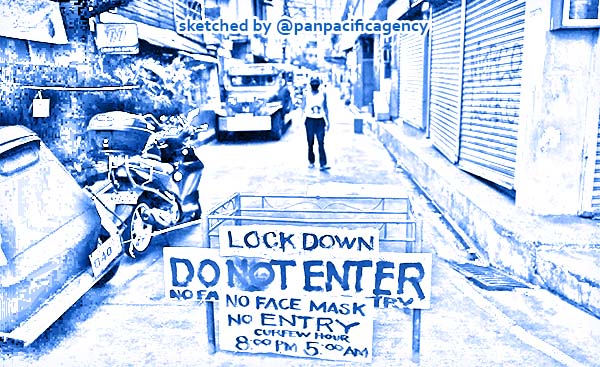Metro Manila likely to remain under lockdown in July: Palace

A makeshift lockdown's barricade blocks a street from outsiders to protect a neighbourhood from the spread of coronavirus disease (COVID-19) in Manila, Philippines, March 23, 2020. REUTERS/Eloisa. Sketched by the Pan Pacific Agency.
MANILA, Jun 28, 2021, PhilStar. Despite its improving COVID-19 numbers, Metro Manila is likely to remain under general community quarantine (GCQ) next month, Malacañang said Monday, The Philippine Star reported.
The capital region, the Philippines’ economic center, has been under GCQ since May 15 but with varying levels of restrictions as the government wants the reopening of the economy to be gradual to avoid another surge in infections.
Metro Manila and the province of Bulacan were placed under “GCQ with restrictions” last June 15, a classification that will lapse on Wednesday.
“The current quarantine classification of Metro Manila is GCQ. Perhaps it is hard to change classification as of now,” presidential spokesman Harry Roque said at a press briefing.
Asked whether Metro Manila may shift to a regular GCQ, Roque replied: “I would say there is a chance but let us just wait for the announcement.”
As of June 27, only 45% of intensive care unit beds, 39% of isolation beds, 32% of ward beds, and 32% of ventilators are being used in the capital region.
Members of the government’s pandemic task force met Monday to discuss the quarantine classifications of areas for next month. President Rodrigo Duterte was scheduled to deliver a public address on Monday night but it was unsure whether the updated groupings would be announced since local governments could still appeal the decision of the task force.
“Since this is the first time we’re talking about the quarantine classification, there will be an opportunity for the local government units to appeal before the recommendations become final to the President,” Roque said.
Roque said Duterte may deliver another public address this week to announce the new quarantine classifications.
Under a regular GCQ, up to 50% of the venues of indoor sports may be filled up. Only up to 30% of such venues may be occupied in areas classified as GCQ with restrictions while indoor sports are not allowed under GCQ with heightened restrictions. The same protocols apply to venues for meetings, conferences and exhibitions and indoor tourist attractions. For outdoor tourist attractions, up to 50% of venues may be filled up for regular GCQ and GCQ with restrictions and 30% for GCQ with heightened restrictions.
For indoor dining, up to half of the restaurants may be occupied for regular GCQ areas, 40% for GCQ with restrictions, and 20% for GCQ with heightened restrictions. The allowed capacity for establishments in areas under GCQ with restrictions and GCQ with heightened restrictions may be raised by 10% if they secure a safety seal issued by the government.
Areas in regular GCQ and GCQ with restrictions are allowed up to 30% of the venues for religious activities but their respective local governments can raise it to up to 50%. For GCQ with heightened restrictions, the allowed capacity for religious activities is 10% but local governments can increase it to 30%.